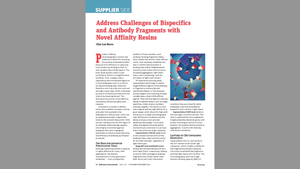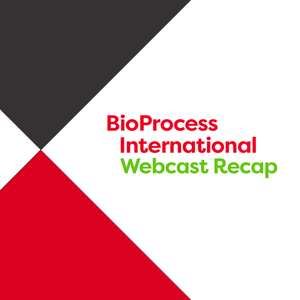November-December 2024
BPI is poised to enter its 23rd year in print. The 21st century has brought many changes to publishing(e.g., from online presence as a “value-add” to an essential) but throughout the decades, some things remain the same for us. We’ve always sought to empower our readers to anticipate, identify, and solve problems in bringing biopharmaceuticals to market around the world. We provide you with an access point to experts and best practices, a resource for discovering the latest technological options, and a forum for discussing business, regulatory, and scientific trends. By targeting key challenges and sharing solutions, BPI provides tailored support to help you make strategic decisions and optimize bioprocesses.
Our mission remains the same even if the industry has changed along the way. Biologic modalities have evolved and matured, bringing new options to the medical toolbox for treating some of the most serious conditions that plague our species. Biotechnologies and other advances have enabled drug discove...
The transition toward industry 4.0 represents a significant evolution in biomanufacturing, driven by the integration of advanced digital technologies in four technological domains: data analytics, automation, cybersecurity, and intelligent sensor systems. Herein, we identify skills gaps in those domains, all of which will be critical to harnessing the full potential of biomanufacturing 4.0. The data analyzed represent demand frequencies over time for technical skills that are necessary for optimizing biopharmaceutical production processes. Understanding such trends in skills supply and demand will be essential in developing targeted educational programs and industry initiatives that can address future workforce needs.
For each technological domain, we analyze the frequency of technical skills in biomanufacturing-sector job postings over five years. Comparing skills that were in demand during 2017 with those at the beginning of 2023 can yield valuable insights into the evolving landscape of biopharmaceutic...
Combination-product growth has surged globally as both physicians and patients request fewer invasive procedures in favor of user-friendly treatment delivery options (
1
). Driven in part by the push for an integrated approach to patient care, the biopharmaceutical industry also has been buoyed by advances in technology. Although drug–device combinations have been marketed around the world for many years, they are playing increasingly crucial roles in patient safety and medicinal usability, with simple drug-release delivery systems such as drug-eluting stents paving the way for products that could reshape medicine (
2
). The market for combination products was worth US$127.8 billion in 2022, and by 2030, analysts expect that value to increase by a compound annual growth rate (CAGR) of 8.9%. (
3
). Sponsors and manufacturers of such products need clarity to navigate different regulatory pathways and determine how local regulations can be leveraged to accelerate approval in new markets.
As of its 2023 guida...
Development and implementation of technologies to support new biopharmaceutical products and processes require companies to take a holistic and collaborative approach to achieve their technical, financial, and sustainability goals (Figure 1). Effectively, a sustainability ecosystem needs to be created toward the common industry goal of innovating, improving, and implementing disruptive technologies that can improve sustainability significantly.
We can draw some inspiration from the origins of the biotechnology community, which came about through a number of innovations. Once daunting tasks, including how to create lifesaving therapies using Chinese hamster ovary (CHO) cells, have become familiar technologies exemplified by products such as Herceptin (trastuzumab) and Keytruda (pembrolizumab) (
1, 2
). Our most audacious current goals also can be achieved through a systematic approach that begins with problem definition followed by application of creativity, strong fundamental science, engineering, and ten...
Bispecific antibodies
(bsAbs) are genetically engineered recombinant proteins with two distinct domains binding to two antigens or epitopes simultaneously (
1
). The concept for bsAbs was proposed by Nisonoff and Rivers in 1961 and later confirmed by Fudenberg et al. in 1964 (
2, 3
). Great progress has been made for bsAb development over the past few decades with the advancements of genetic engineering approaches, protein modeling and simulation technologies, and manufacturing processes and experience (
4–8
). As Table 1 shows, bsAbs demonstrate versatile mechanisms of actions (MoAs) such as cell bridging (e.g., mosunetuzumab-axgb), blood coagulation factor-bridging (e.g., emicizumab-kxwh), receptor-activating or -blocking (e.g., ozoralizumab and faricimab-svoa), receptor or ligand internalization or clustering, cofactor mimicking (e.g., emicizumab-kxwh), and retargeting of cytotoxic effector cells (
7
).
By the end of 2023, 14 bsAbs were approved by global regulatory authorities (Table 1, Figure 1). Mo...
A typical sequence of pharmaceutical manufacturing and equipment cleaning operations in a multiproduct facility is shown in Figure 1. An important regulatory requirement for
intercampaign cleaning
— cleaning between batches of different products — is that the carryover of the previously manufactured active pharmaceutical ingredient (API
A
) into a therapeutic dose of the subsequently manufactured product (Product B) must be acceptable from the standpoint of patient safety (
1–5
).
That requirement also applies to the preparation of newly manufactured and reusable medical devices. In either case, the criterion for patient safety is generally specified in terms of the acceptable exposure level (AEL) of the contaminant, which is API
A
in this example (
6–8
).
Inactivation of Proteins During Cleaning and Sanitization:
Biopharmaceutical cleaning and sanitization cycles are designed to expose product-contact equipment to high pH (>13) and temperature (60–120 °C) for several minutes. Under those conditions, ...
Chinese hamster ovary (CHO) cell lines are a highly efficient expression platform widely used in biotherapeutic manufacturing. However, CHO cell-derived impurities, including host-cell proteins (HCPs), remain significant concerns for patient safety and product stability. HCPs originating from manufacturing cells can induce adverse immune responses in patients (
1
). HCPs also have been shown to reduce stability and shelf life of therapeutic monoclonal antibodies (mAbs) and excipients (
2, 3
). Strong interactions between biotherapeutic materials and HCPs can occur, leading to copurification of HCPs alongside biologic products. Thus, HCPs are critical quality attributes (CQAs) that require constant process optimization for clearance throughout biomanufacturing (
4
).
Several purification steps can reduce and remove HCPs: e.g., depth filtration and chromatography based on protein A affinity, anion exchange (AEX), cation exchange (CEX), and hydrophobic interaction (HIC). HCP levels should be tested and contr...
The biopharmaceutical industry is on the brink of a paradigm shift with the release of the
United States Pharmacopeia
(USP) General Chapter <1132.1> “Residual Host Cell Protein Measurement in Biopharmaceuticals by Mass Spectrometry,” which was published on 1 December 2024 (
1
). The chapter presents best practices for standardized mass spectrometry (MS)-based host cell protein (HCP) analyses to enable comprehensive and reproducible impurity profiling in biologics, improving their quality and consistency. The chapter also marks a turning point in regulatory approaches.
HCPs are process-related impurities generated during manufacturing of monoclonal antibodies (mAbs), other recombinant proteins, vaccines, and advanced therapies; therefore, monitoring HCPs is critical for ensuring product quality, safety, and efficacy. Previously, manufacturers have focused on reducing and monitoring total HCP levels, but health authorities now emphasize the monitoring of specific HCPs that can affect product quality. With...
Drug developers know well the analytical obstacles associated with cell therapies (CTs). Human cells’ large size and biochemical complexity present considerable difficulties for characterization and manufacturing-process control. Because advanced therapies are still novel drug modalities, their critical quality attributes (CQAs) remain poorly defined. In the case of autologous CTs, product quality hinges on material obtained from extremely ill patients who might have undergone several previous lines of treatment. And CTs are “living products” that change over time and will participate dynamically in biological pathways. Allogeneic products introduce even more complexity for manufacturing because of inherent variability across materials from different healthy donors.
Despite incremental technological improvements over the past decade, the CT industry needs analytical methods that can account for cells’ complexity and dynamism. As I learned from Renée Hart (president and chief business officer of LumaCyte),...
Advancements in the field of therapeutic antibody design and upstream production continue to challenge traditional downstream purification processes. As the complexity and titer of target molecules increase, both recovery and separation from the various product related impurities becomes non-standard, and exploration of advanced chromatography tools is essential for efficient purification schemes.
One promising technique is the use of affinity resins that target different antibody subdomains distinct from protein A to increase yield and purity of challenging feeds, reducing the burden on subsequent polish steps.
This article presents use-cases from literature where affinity chromatography resins targeting the CH1 region, Fc region, and kappa and lambda light chains are successfully employed to increase purity and yield of various bispecific antibody (bsAb) feeds with challenging impurity profiles.
Fill out the form below to read the full article.
Data integrity
refers to data that are complete, accurate, consistent, and secure throughout their entire life cycle. The concept is essential for bioprocessing because it underpins demonstration of drug-product safety, efficacy, and quality. Regulatory agencies such as the US Food and Drug Administration (FDA) mandate strict data-integrity requirements. Specifically, Title 21 of the
Code of Federal Regulations
(CFR) notes that all data must be recorded and maintained accurately to ensure the safety and quality of drug products. Maintaining data integrity reduces the risk of recalls and ensures patient safety by mitigating the potential for adverse reactions. Moreover, data integrity prevents falsification and enhances confidence in drug manufacturers. In a 2024 Ask the Expert webinar, Shweta Nair (senior product manager for biopharmaceuticals at Advanced Instruments) talked about secure data recording and management during biomanufacturing processes.
ALCOA+ Principles:
Nair noted that good documentat...
Single-use (SU) bioprocessing has enabled optimization and innovation for many biomanufacturing processes. Specific facilities have particular needs, and by collaborating with suppliers that have expertise in design, extrusion, molding, fabrication, and assembly, biomanufacturers can leverage vendor knowledge to enhance bioprocess development. Collaborative relationships between suppliers and end users are vital for the success of SU solutions. Three Repligen team members — Gregory Verni (vice president of fluid management), Derek Masser (director of business and market development), and Scott Bendon (senior director of research and development, R&D) — presented three case studies to demonstrate the importance of such collaborative relationships in a September 2024 Ask the Expert webinar.
Keep an Open Mind:
One company planned to use an automated filling machine to aliquot buffers into 125-mL preparations several thousand times annually and needed a SU supplier to create a compatible flow path. The compa...
Cancer clinical trials are crucial for developing lifesaving treatments, but historically low enrollment rates and a lack of diversity among participants have hampered progress. Only 3–5% of adult cancer patients in the United States and <5% globally participate in clinical trials, largely because of stringent eligibility criteria and trial-site inaccessibility (
1
). Technological advancements such as modern software platforms and artificial intelligence (AI) are revolutionizing patient recruitment and retention, particularly for underrepresented communities. Modern technologies can streamline clinical-trial processes, starting at enrollment and assisting with patient engagement and retention, remote patient monitoring, and reporting.
Challenges and Solutions in Cancer Clinical Trials:
Clinical investigators must overcome a number of obstacles to run successful clinical trials. Studies show that 25% of cancer trials fail to meet their enrollment targets, for the reasons mentioned above (
2
). Patient he...
Subscribe to receive our monthly print or digital publication
Join our 70,000+ readers. And yes, it's completely free.

















